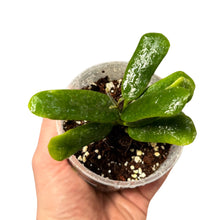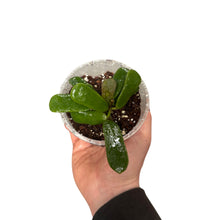Hoya rotundiflora is part of the Apocynaceae family and it is native to Myanmar; it was originally found in a market in Thailand 2005. From 2007 it was sold commercially under the name Hoya sp. ‘Square’. Hoya rotundiflora is described as being a “pendulous to weakly climbing vine with white latex in all parts.” Leaves are oblong-pandurate in shape and fleshy with a hirsute leaf surface.
Inflorescences are positively geotropic with up to 20 flowers per umbel; the revolute corolla lobes make the flowers look globose. The scent of the flowers is described as sweet and jasmine-like, with the smell being stronger in the evenings.
Genus name is new Latin, named after Thomas Hoy ( c. 1750– c. 1821), English gardener. Specific epithet is from the Latin rotundus, meaning round and folium meaning leaf.
9cm potted plant in a coco husk plug with coco coir, coco chips, perlite and pine bark. We do not recommend removing the plant from the coco husk plug.
The picture shown is an example of what's in stock. You will receive a plant as close to the picture and description as possible.
Light: Bright indirect light, meaning the plant sees the sun for 0-4 hours per day - this could be through trees or a translucent curtain, it’s important for the plant to see the sky in order to thrive. Keep direct light to a minimum for this Hoya.
Water: Allow the potting mix to dry out at least halfway through before watering.
Potting mix: Our potting mix would be ideal with some added coco chips.
Fertilising: Feed every couple of waterings with a well balanced fertiliser; you can further dilute fertiliser than the recommended amount but never add more.
Temperature: 15-35˚C with obvious disparity between day time and night time temperatures as it is thought to likely inhabit higher elevated areas.
Humidity: 60% and above with good air circulation.
Hoya aren’t considered toxic, however, they may make your pet or child vomit if ingested, keep out of reach just to be safe.



